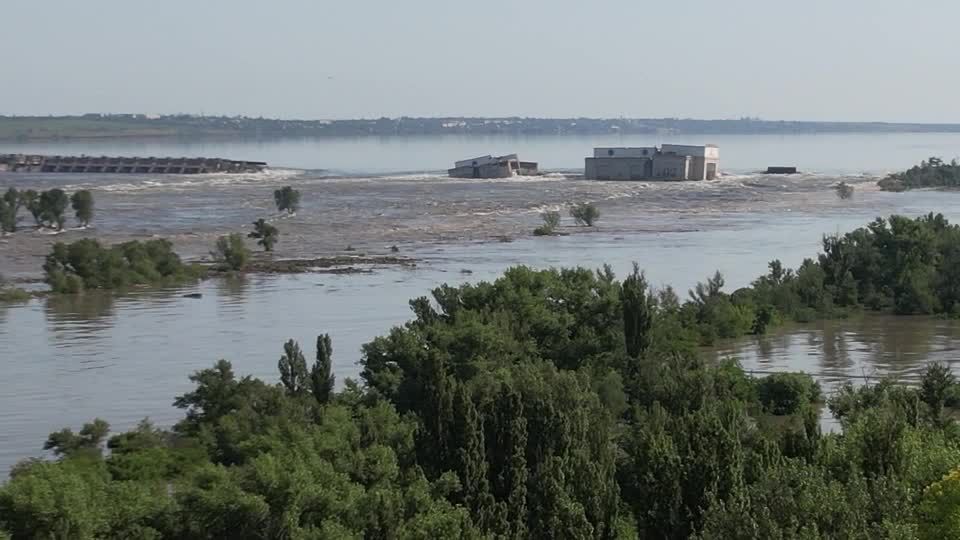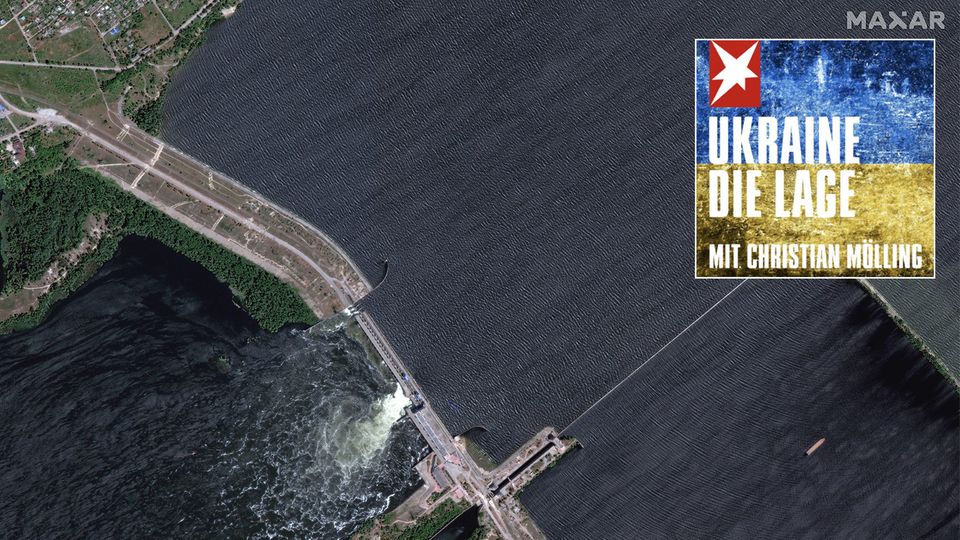The Kakhovka dam on the Dnipro was destroyed, 18 cubic kilometers of water flooded an entire region. Who is behind the incident and what are the consequences for the war and the people? The most important questions and answers.
Table of contents
The destruction of the Kakhovka dam and the adjacent hydroelectric power station is another terrible low point in Russia’s war of aggression against Ukraine, which has been going on for more than 15 months. Even one day after the dramatic incident, there are still many unanswered questions.
what we know
The area: The Kakhovka Dam and adjacent hydroelectric power station are located in the town of Nowa Kakhovka in the Russian-occupied part of Ukraine’s Kherson region. Russia invaded neighboring Ukraine in February 2022 and then occupied the Cherson region. However, the regional capital of the same name is under Ukrainian control, while cities south of the Dnipro such as Nowa Kakhovka are in Russian hands. The river, which roughly represents the front line in this area, is being dammed in Nowa Kachowka for the sixth and last time before the Black Sea for a length of 200 kilometers.
The Desolations: After a heavy explosion at the important dam, the adjacent hydroelectric power station was also affected, according to both warring parties. The dam, which was close to the war front and went into operation in the mid-1950s, has been destroyed, as has the hydroelectric power station. It is believed that the dam was blown up. According to Ukrainian President Volodymyr Zelenskyy, the detonation took place early Tuesday morning around 2:50 a.m. local time (1:50 a.m. CEST).
The past: It has long been feared that the dam could be destroyed and the area flooded. Because it is not the first time that he has been the target of attacks in the Ukraine war. In autumn 2022, for example, Ukrainian forces attacked the bridge over the dam with precision strikes and disrupted Russian supplies. Russian troops, on the other hand, had caused further considerable damage when retreating with controlled demolitions. Soon the bridge was no longer passable. There was particular concern when the occupiers announced the evacuation of Nowa Kakhovka in November.
The nuclear power plant: The International Atomic Energy Agency (IAEA) and the Russian nuclear company Rosenergoatom agree that there is no immediate danger for the Zaporizhia nuclear power plant at the northern end of the reservoir. According to the IAEA, however, measures are being taken in the nuclear power plant occupied by Russia to continue operating the cooling systems, which are normally fed with the dammed water. Reactor cores and nuclear waste must be prevented from dangerously overheating.
What we don’t know
The responsibility: Moscow and Kiev blame each other for the explosion. While Ukraine accuses Russia of state terrorism and compares the act to the use of a weapon of mass destruction, Moscow accuses Ukrainian troops of shelling and deliberate sabotage. Neither side has provided any evidence so far.
The USA and Great Britain expressed reservations. In Washington, the spokesman for the White House National Security Council, John Kirby, said the situation could not be finally assessed. “We continue to try to collect information and talk to the Ukrainians.” Great Britain’s Prime Minister Rishi Sunak said late on Tuesday evening that he “cannot say whether there is intent behind it”. It was “too early” to make a “final judgment” on the dam collapse.
Chancellor Olaf Scholz (SPD) accused Moscow of increasingly attacking civilian targets. For NATO Secretary General Jens Stoltenberg, the crime shows “once again the brutality of Russia’s war in Ukraine.”
Kakhovka Dam
Destruction on the Dnipro: “The biggest man-made environmental disaster in Europe for decades”
The motif: It is speculated that the incident could be a Russian act of sabotage to slow down a Ukrainian counter-offensive. Moscow denies that. The floods are particularly affecting the Russian-held region south of the Dnipro River, which is said to be a key target of such a possible advance. During the Second World War, the then Russian secret service NKDW had already blown up the dam in order to destroy the infrastructure because of the advancing German Wehrmacht.
The security expert Christian Mölling called it in the starPodcast “Ukraine – the situation” “extremely unlikely” that the dam was not attacked by Russian forces. It is possible that the Russian actors calculated that the delay in a Ukrainian offensive should be rated more highly than possible disadvantages. At the same time, he emphasized: “This is a delay, but not a prevention of the offensive.”
The effects: It is still unclear to what extent the floods will devastate the area. Much of the area downstream of the dam on the banks of the Dnipro is already under water. The situation is most difficult in the Korabel district of the city of Kherson, said the Deputy Chief of Cabinet of the Ukrainian President, Oleksiy Kuleba. The water in the city, which is around 50 kilometers downstream as the crow flies, has reached a level of 3.5 meters and more than 1000 houses are flooded. Ukrainian authorities had initiated the evacuation of around 17,000 people on Tuesday, and another 25,000 residents were to be brought to safety on the side occupied by Russia.
Scientists from the Magdeburg-Stendal University of Applied Sciences calculated in an early model that 60,000 people could be affected, about a third of them at risk. The EU spoke of hundreds of thousands of civilians whose lives are at risk.

The environmental catastrophe: According to information from the Ukrainian leadership, which cannot be independently verified, at least 150 tons of machine oil leaked into the Dnipro River. Another 300 tons of oil threatened to leak. Flora and fauna are also severely affected.
According to initial estimates, the Ukrainian Ministry of Agriculture expects around 10,000 hectares of agricultural land to be flooded on the northern bank of the Dnipro in the Cherson region. On the southern bank, in the Russian-occupied area, a multiple of this area will be flooded, the ministry writes on its website. “Moreover, the man-made disaster will disrupt the water supply of 31 field irrigation systems in the Dnepropetrovsk, Kherson and Zaporizhia regions,” the ministry said. “The destruction of the Kakhovka hydroelectric power plant will mean that the fields in southern Ukraine could turn into deserts as early as next year,” it said. According to the Ministry of Agriculture, it also expects negative consequences for fisheries.
The supply: Southern locations and also the Black Sea peninsula of Crimea, which was annexed by Russia, could face a water shortage because they are supplied from the Kachowka reservoir. That will become apparent in the coming days. The grain harvest in Crimea may also be affected. Villages upstream could also be affected if the huge water reservoir, for example for agriculture, is missing. The destruction of the hydroelectric power station could also contribute to Ukraine’s energy problems.


